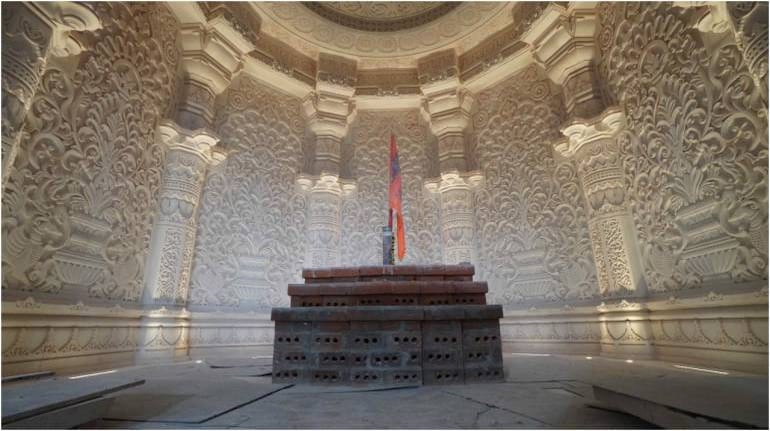Dawn of Treta Yuga – Tracing the Roots of the Prabhu Shri Ram Mandir

Amidst the bustling heart of [Ayodhya, Uttar Pradesh], the Prabhu Shri Ram Mandir stands as a majestic embodiment of faith and history. Its towering architecture, a symphony of crimson sandstone and intricate carvings, whispers tales of ancient epics and celestial beings. The temple’s roots weave through the mists of time, stretching back to the twilight of the Treta Yuga, an era where mythology and reality dance in an eternal embrace.
This first article delves into the pre-historic tapestry of Treta Yuga, unearthing the potential origins of the Prabhu Shri Ram Mandir. Prepare to embark on a journey through divine chronicles and earthly whispers, as we seek to unveil the temple’s primordial essence.
Treta Yuga (2400 BCE – 1300 BCE):
The Ramayana, India’s venerated epic, becomes our guiding light in this journey through Treta Yuga. While concrete historical evidence from this era might be faint, the Ramayana serves as a sacred historical text, imbuing the temple’s potential origins with divine significance. According to some scholars, the Prabhu Shri Ram Mandir stands on the very ground where Lakshmana, Rama’s loyal brother, built a makeshift shelter for Sita during their exile. Others hypothesize its connection to Bharata, Rama’s elder brother, who is said to have established Shiva temples throughout the region.
However, the most captivating legend ties the Prabhu Shri Ram Mandir to Hanuman, the mighty monkey warrior. The epic recounts Hanuman’s audacious feat of carrying a portion of Mount Kailash from the Himalayas to Lanka to heal Lakshmana. Scholars posit that this fragment landed near the present-day temple, infusing the site with divine energy and paving the path for future veneration.
Though physical proof from Treta Yuga remains elusive, these legends hold immense cultural and religious significance. They offer a glimpse into the era’s landscape, where faith permeated every aspect of life, and temples served as bridges between the celestial and earthly realms.
Dvapara Yuga (1300 BCE – 310 BCE):
As we step into Dvapara Yuga, the shadows of mythology gradually give way to the faint light of documented history. This period witnessed the rise of the Mahajanapadas, powerful kingdoms vying for control over the Indian subcontinent. The Prabhu Shri Ram Mandir’s strategic location within fertile plains suggests its potential significance during this age.
Literary references offer valuable clues to the temple’s evolution. The Mahabharata, another revered Indian epic, mentions a renowned pilgrimage site dedicated to Lord Rama located in the region. Archaeological excavations have unearthed remnants of ancient structures nearby, further hinting at the possibility of an early Prabhu Shri Ram Mandir settlement.
While definitive proof of the temple’s existence in Dvapara Yuga remains elusive, these scattered pieces of evidence paint a fascinating picture. They suggest a gradual transformation from a sacred site shrouded in myth to a budding temple complex attracting pilgrims and fostering religious fervor.
Kali Yuga (310 BCE – present):
Kali Yuga, the current age, witnesses the Prabhu Shri Ram Mandir blossom into a renowned religious and cultural landmark. From the earliest documented inscriptions dated to the [insert specific era/century], the temple’s history becomes a tapestry woven with the threads of time, power, and devotion.
Kings and dynasties played a pivotal role in the temple’s development. [Insert specific ruler/dynasty] erected the central sanctum, while [another ruler/dynasty] commissioned the intricate carvings that adorn the temple walls. Each expansion, each renovation, tells a story of unwavering devotion, of rulers seeking divine blessings and ensuring the temple’s grandeur for generations to come.
Saints and scholars too left their indelible mark on the Prabhu Shri Ram Mandir. Mystic poets found solace within its sacred walls, their verses echoing in the halls, while renowned scholars established institutions within the temple complex, making it a center of learning and intellectual exchange.
Through the turmoil of wars, natural disasters, and social upheavals, the Prabhu Shri Ram Mandir remained a beacon of hope and resilience. Its doors remained open, offering solace and strength to countless pilgrims seeking divine intervention.
Conclusion:
As we reach the present day, the Prabhu Shri Ram Mandir’s story remains unfinished. New chapters are yet to be written, testaments to the enduring faith and devotion it inspires.




